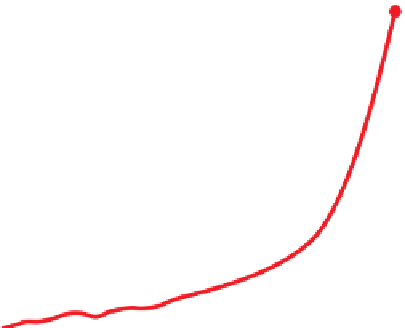Geography Reference
In-Depth Information
Population Growth within Countries
The information provided in Figure 2.7 is based on
countrywide statistics. Signifi cant demographic varia-
tions also occur
within
countries. Political geographers
call countries states. State governments partition their
countries into administrative units called States (United
States), provinces (Canada), departments (France) or the
like. In India, for example, States in the north record
population growth rates far above the national average
(Fig. 2.11). But other States, in the west and southwest
region, have populations that are growing much more
slowly. Women in southern India have higher female lit-
eracy, greater land ownership rates, better access to
health care, and more access to birth control methods.
All of these factors keep the growth rates lower in the
south than the north of India.
In the 1950s, India became the fi rst country in the
world to institute a population planning program, before
the fear of worldwide overpopulation and a global popula-
tion bomb spread. In the 1960s, when census numbers
revealed the extreme growth rates in the north, the Indian
government instituted a national population planning
program, encouraging States to join.
Despite the federal effort, rapid population growth
continues, especially in the northern and eastern States.
India is a federation of 28 States and 7 union territories,
and the individual States differ greatly both culturally and
politically. Social problems arose in some of the States
where governments pursued the population planning
campaign vigorously. During the 1970s, the Indian gov-
ernment began a policy of forced sterilization of any man
with three or more children. The State of Maharashtra
sterilized 3.7 million people before public opposition led
to rioting, and the government abandoned the program
(Fig. 2.12). Other States also engaged in compulsory ster-
ilization programs, with heavy social and political costs—
eventually, 22.5 million people were sterilized.
The horrors of the forced sterilization program of
the 1970s are haunting India again. In 2004, three dis-
tricts in the State of Uttar Pradesh (India's most popu-
lous State with over 170 million people) instituted a
policy of exchanging gun licenses for sterilization. The
policy allowed for a shotgun license in exchange for the
sterilization of two people and a revolver license in
exchange for the sterilization of fi ve people. Abuse
began almost immediately, with wealthy landowners
sterilizing their laborers in exchange for gun licenses.
Before the “guns for sterilization” policy, districts in
Uttar Pradesh encouraged sterilization by providing
access to housing and extra food for people who agreed
to be sterilized.
Today, most Indian State governments are using
advertising and persuasion—not guns for sterilization—to
encourage families to have fewer children. Posters urging
10
2045
9 billion
9
2027
8 billion
8
2012
7 billion
7
2000
6 billion
6
5
1975
4 billion
4
3
1930
2 billion
2
1820
1 billion
1
0.5
billion
0
Time
Figure 2.10
Population Growth, 1650 to 2050.
The dashed line indi-
cates one estimate of global population growth for the next 50
years.
Data from
: United States Census Bureau, International
Data Base, 2011.
fact, current predictions point to zero population growth
globally by the end of the century, with population rising
to 9.3 billion by 2050 and then leveling off around
10 billion people.
No single factor can explain the variations shown
in Figure 2.7. Economic prosperity as well as social dis-
location reduce natural population growth rates. Eco-
nomic well-being, associated with urbanization, higher
levels of education, later marriage, family planning, and
other factors, lowers population growth. In the table
presented in Appendix B, compare the indices for natu-
ral population increase and the percentage of the popu-
lation that is urbanized. In general, the higher the
population's level of urbanization, the lower its natural
increase. Cultural traditions also infl uence rates of pop-
ulation growth, Religion, for example, has a powerful
impact on family planning and thus on growth rates, not
only in Islamic countries but also in traditional Chris-
tian societies (note the Roman Catholic Philippines'
growth rate) and in Hindu-dominated communities
(such as India).












































































